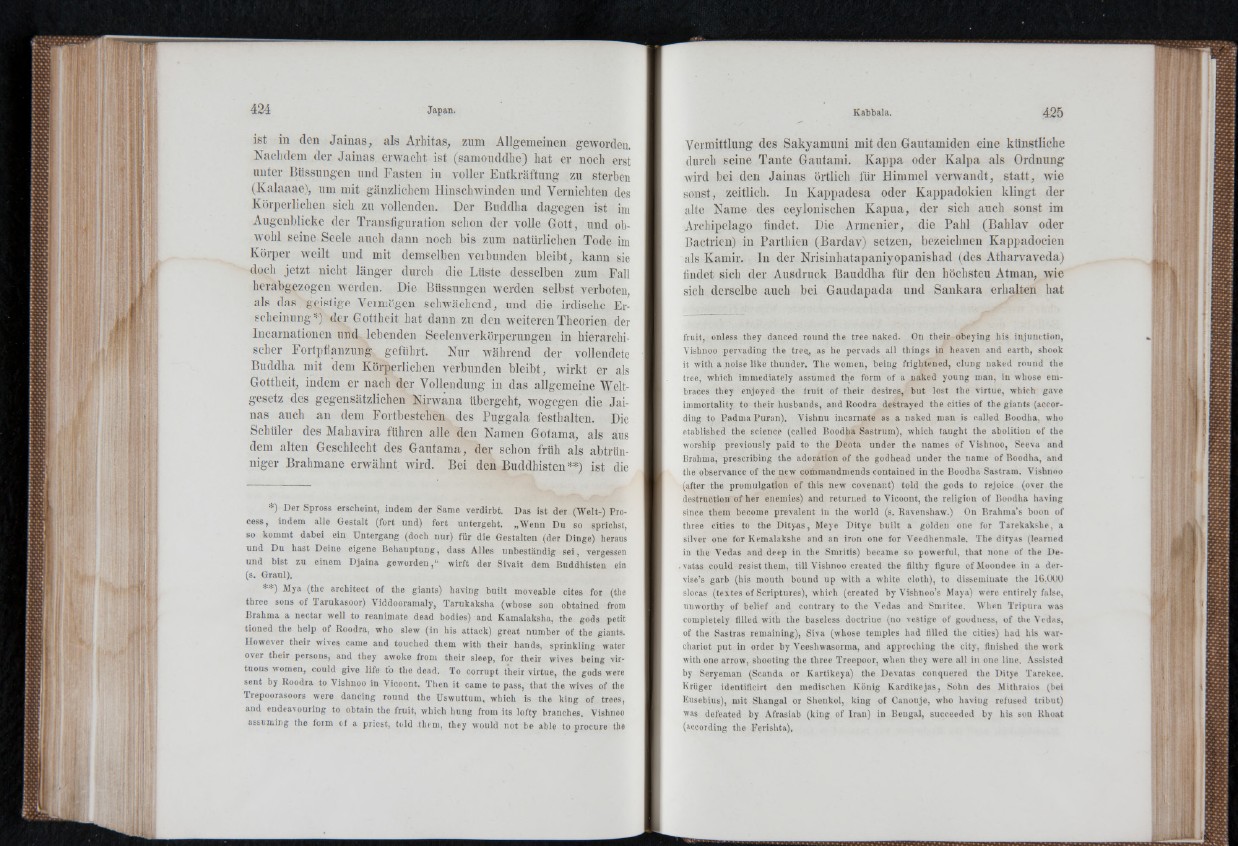
ist in den Ja in a s, als Arhitas, zum Allgemeinen geworden.
Nachdem der Jainas erwacht ist (samouddhe) hat er noch erst
unter Btissungen und Fasten in voller Entkräftung zu sterben
(Kalaaae), um mit gänzlichem Hinschwinden und Vernichten des
Körperlichen sich zu vollenden. Der Buddha dagegen ist im
Augenblicke der Transiiguration schon der volle Gott, und obwohl
seine Seele auch dann noch bis zum natürlichen Tode im
Körper weilt und mit demselben verbunden bleibt, kann sie
doch jetzt nicht länger durch die Lüste desselben zum Fall
herabgezogen werden. Die Büssungen werden selbst verboten,
als das geistige Vermögen schwächend, und die irdische Erscheinung*)
der Gottheit hat dann zu den weiteren Theorien der
Incarnationen und lebenden Seelenverkörperungen in hierarchischer
Fortpflanzung geführt. Nur während der vollendete
Buddha mit dem Körperlichen verbunden bleibt, wirkt er als
Gottheit, indem er nach der Vollendung in das allgemeine Weltgesetz
des gegensätzlichen Nirwana übergeht, wogegen die Jainas
auch an dem Fortbestehen des Puggala festhalten. Die
Schüler des Mahavira führen alle den Namen Gotama, als aus
dem alten Geschlecht des Gautama, der schon früh als abtrünniger
Brahmane erwähnt wird. Bei den Buddhisten**) ist die
*) Der Spross erscheint, indem der Same verdirbt. Das ist der (Welt-) Proce
ss, indem alle Gestalt (fort und) fort untergeht. „Wenn Du so sprichst,
so kommt dabei ein Untergang (doch nur) für die Gestalten (der Dinge) heraus
und Du hast Deine eigene Behauptung, dass Alles unbeständig s e i, vergessen
und hist zu einem Djaina geworden,“ wirft der Sivait dem Buddhisten ein
(s. Graul).
**) Mya (the architect of the giants) having built moveable cites for (the
three sons of Tarukasoor) Viddooramaly, Tarukaksha (whose son obtained from
Brahma a nectar well to reanimate dead bodies) and Kamalaksha, the gods petit
tioned the help of Roodra, who slew (in his attack) great number of the giants.
However their wives came and touched them with their hands, sprinkling water
over their persons, and they awoke from their sleep, for their wives being virtuous
women, could give life to the dead. To corrupt their virtue, the gods were
sent by Roodra to Vishnoo in Vicoont. Then it came to pass, that the wives of the
Trepoorasoors were dancing round the Uswuttum, which is the king of trees,
and endeavouring to obtain the fruit, which hung from its lofty branches. Vishnoo
assuming the form of a priest, told them, they would not be able to procure the
Vermittlung des Sakyamuni mit den Gautamiden eine künstliche
durch seine Tante Gautami. Kappa oder Kalpa als Ordnung
wird bei den Jainas örtlich für Himmel verwandt, s ta tt, wie
sonst, zeitlich. In Kappadesa oder Kappadokien klingt der
alte Name des ceylonischen Kapua, der sich auch sonst im
Archipelago findet. Die Armenier, die Palil (Bahlav oder
Bactrien) in Parthien (Bardav) setzen, bezeichnen Kappadocien
als Kamir. In der Nrisinhatapaniyopanishad (des Atharvaveda)
findet sich der Ausdruck Bauddha für den höchsteu Atman, wie
sich derselbe auch bei Gaudapada und Sankara erhalten hat
fruit, onless they danced round the tree naked. On their obeying his injunction,
Vishnoo pervading the tree., as he pervads all things in heaven and earth, shook
it with a noise like thunder. The women, being frightened, clung naked round the
tree, which immediately assumed the form of a naked young man, in whose embraces
they enjoyed the fruit of their desires, but lost the virtue, which gave
immortality to their husbands, and Roodra destrayed the cities of the giants (according
to Padma Puran). Vishnu incarnate as a naked man is called Boodha, who
etablished the science (called Boodha Sastrum), which taught the abolition of the
worship previously paid to the Deota under the names of Vishnoo, Seeva and
Brahma, prescribing the adoration of the godhead under the name of Boodha, and
the observance of the new commandmends contained in the Boodha Sastram. Vishnoo
(after the promulgation of this new covenant) told the gods to rejoice (over the
destruction of her enemies) and returned to Vicoont, the religion of Boodha having
since them become prevalent in the world (s. Ravenshaw.) On Brahma’s boon of
three cities to the Dityas, Meye Ditye built a golden one for Tarekakshe, a
silver one for Kemalakshe and an iron one for Veedhenmale, The dityas (learned
in the Vedas and deep in the Smritis) became so powerful, that none of the De-
vatas could resist them, till Vishnoo created the filthy figure of Moondee in a der-
vise’s garb (his mouth bound up with a white cloth), to dissemiuate the 16.000
slocas (textes of Scriptures), which (created by Vishnoo’s Maya) were entirely false,
uuworthy of belief and contrary to the Vedas and Smritee. When Tripura was
completely filled with the baseless doctriue (no vestige of goodness, of the Vedas,
of the Sastras remaining), Siva (whose temples had filled the cities) had his war-
chariot put in order by Veeshwasorma, and approching the city, finished the work
with one arrow, shooting the three Treepoor, when they were all in one liue. Assisted
by Seryeman (Scanda or Kartikeya) the Devatas conquered the Ditye Tarekee.
Kruger identiflcirt den medischen Konig Kardikejas, Sohn des Mithraios (bei
Eusebius), mit Shangal or Shenkol, king of Canouje, who having refused tribut)
was defeated by Afrasiab (king of Iran) in Bengal, succeeded by his son Rhoat
(according the Ferislita).